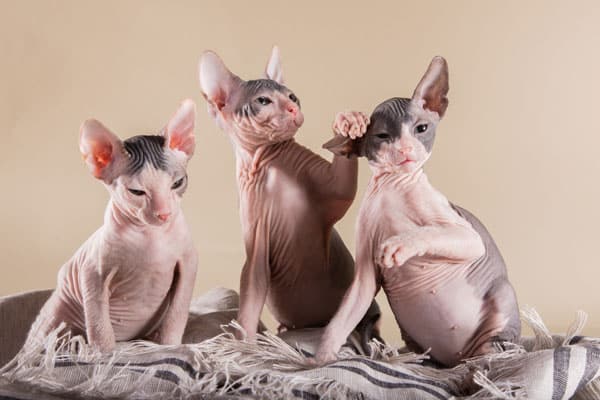Love cuddling with furry felines but curious about their naked counterparts? Prepare to have your appetite sated with this crash course on hairless cat breeds. A word of warning: by the end of this article you’re definitely going to want to add one of these cuties to your feline family!
1. Bambino
A Bambino cat. Photography ©peterpancake | iStock / Getty Images Plus.
Have you met the Munchkin? What about the Sphynx? Well … say hello to the Bambino — a too-cute-to-handle cross between the two with lemon-like eyes set upon a wedge-shaped head. A relatively new breed (created in 2005!), the Bambino is classified as a dwarf, and has the short, well-muscled legs to prove it. Do they slow him down in any way? Not a bit! He takes corners like a race car and has the activity and energy levels of his Italian namesake: a baby, small child or toddler!
Though part of the small cat committee (Bambinos weigh, on average, between 4.9 and 8.8 pounds), this baby is big on character, compassion and cuddles, and will quickly capture your heart!
Fun fact: As with all hairless cat breeds, Bambinos are not hypoallergenic. They produce the same allergy-causing Fel d 1 as furred felines.
2. Donskoy
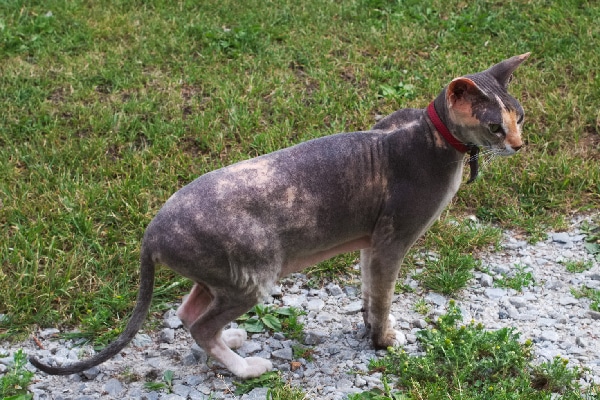
Donskoy cat. Photography by Flickr user stanze under Creative Commons License. Some modifications have been made to fit the specifications of this site.
If a man of mystery holds the key to your heart then you’ll adore the Donskoy — a hairless heartthrob with a quartet of aliases: Don Sphynx, Russian Hairless, Russian Donskoy and Don Hairless! The first Donskoy was discovered in 1987 by Elena Kovaleva in Russia. Kovaleva rescued the kitten from boys who were being mean to her. As time passed, the kitten, named Varvara, lost her hair … and when she gave birth to a litter of kittens they lost their hair as well! First believed to be an illness or disease, a professional breeder finally stepped in and realized that a new breed was born: the Donskoy!
Known for their dog-like loyalty, the Donskoy doesn’t require loads of attention and interaction — he demands it! Intelligent and friendly, the Donskoy is highly inquisitive, making him an easy feline to train.
Fun fact: Donskoys grow a winter coat (most frequently seen on their chest and tail) during the chilly months, then shed it again when the temps rise!
3. Peterbald
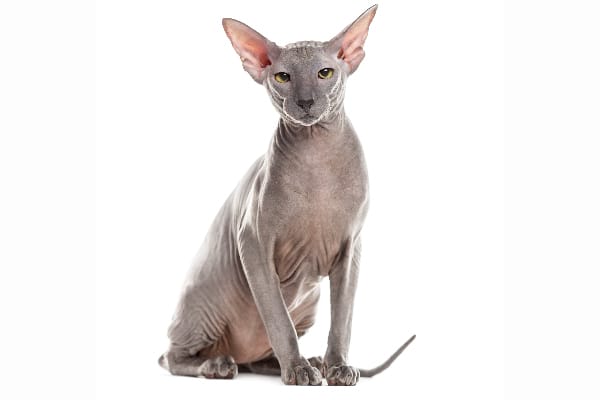
Peterbald cat. Photography ©GlobalP | iStock / Getty Images Plus.
You know the Donskoy you met above? Well, the Peterbald has ties to that dashing fellow! How so? The Peterbald is a cross between the Donskoy and the Oriental Shorthair — giving him the sophisticated look of a Siamese in hairless form! Affection runs high when it comes to the Peterbald — he will curl up under the covers with you come bedtime and sit by your side during all meals.
As with Orientals, Peterbalds are highly vocal and love to converse with their humans — they’ll also see you off in the morning and greet you at the front door when you return in the evening. How’s that for devotion?
Fun fact: Peterbalds, like all hairless kitties, have a higher metabolism than cats with full coats, making more food an essential. Even more intriguing? That fast metabolism makes scratches and wounds on their skin heal faster!
4. Sphynx
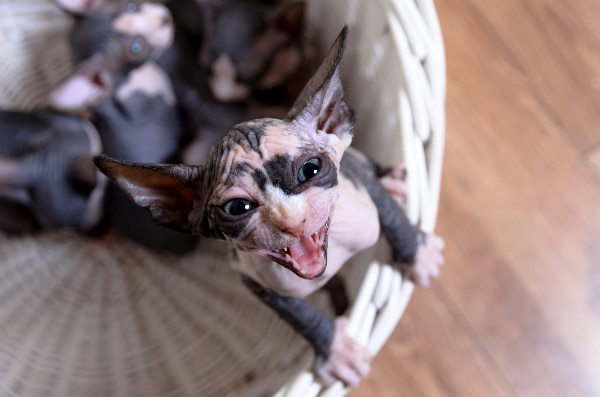
Sphynxes can have patterned skin! Photography by Oleg Mikhaylov / Shutterstock.
Out of every hairless cat breed, the Sphynx is likely the one you’ve heard of before — and that has quite a bit to do with his appearance in pop culture. After all, Mr. Bigglesworth of the popular Austin Powers film franchise was a Sphynx … and nearly stole the screen from Mike Myers!
Celeb status aside, the Sphynx was ranked the eighth most popular cat breed in 2016 by the Cat Fanciers’ Association — an honor likely attributed to his debonair good looks and friendly persona. Sphynxes were also ranked the most affectionate cat breed by the Journal of Veterinary Behavior.
Fun fact: Though naked, not all Sphynx skin is the same — it comes in patterns and colors that mimic that of their furred familia. Sphynxes even come in tabby and tortie shades!
5. Ukrainian Levkoy
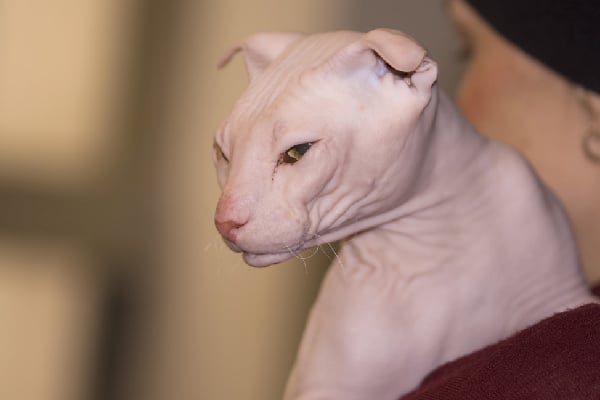
Ukrainian Levkoy cat. Photography by Flickr user Nickolas Titkov under Creative Commons License. Some modifications have been made to fit the specifications of this site.
A cross between a Donskoy and a Scottish Fold, the Ukrainian Levkoy is, perhaps, the most unique cardholder of the hairless cat crew because she has not one signature feature, but two: being completely hairless, and possessing those squeal-worthy folded ears! Though the Ukrainian Levkoy loves attention and affection, she isn’t overly demanding of it and finds contentment even when on her own.
She’s slightly standoffish at first, but once the Ukrainian Levkoy gets to know you she is all about the cuddles and gets along with everyone — from children to adults to other animals.
Fun fact: A relatively new breed (her origins only date back to the early 2000s!), the Ukrainian Levkoy sports wrinkles all over her hairless form, which gives her an even more distinctive look!
What to Know About Hairless Cat Breeds
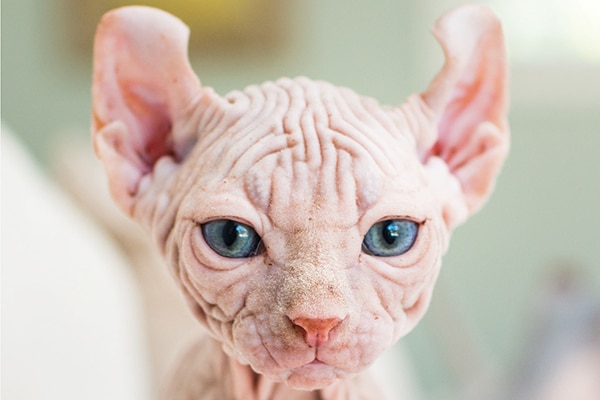
Hairless cats don’t automatically mean low-maintenance cats! Photography by Gareth Cowlin/Shutterstock.
Think you want to parent one of these hairless cat breeds? A few things to note—
- Some hairless cat breeds (for example, the Donskoy and Peterbald) have a handful of coat types that give the slightest hint of fur (from rubber bald to flocked and brush to velour), but the Sphynx, Bambino and Ukrainian Levkoy are covered in a fine, downy fuzz, making them feel like suede.
- Hairless cat breeds as a whole are highly intelligent and inquisitive, with dog-like loyalty and affection. Given that, they do need mental stimulation and loads of love from their humans.
- One way to show them a little TLC is through their grooming routine. While furred felines take care of most grooming on their own with little help from their humans, hairless kitties need a little more assistance. Daily wipe-downs all over their bodies help to absorb excess oils that would typically be soaked up by fur; and monthly (or more frequently, as needed) baths prevent skin problems. Clean the ears weekly to prevent infection and remove wax build-up and debris. Hairless cat breeds also need sun protection. Use an SPF formulated for kitties to avoid sunburn, and a sweater for those chillier months.
Thumbnail: Photography by dezy / Shutterstock.
Read more about cat breeds on Catster.com:
